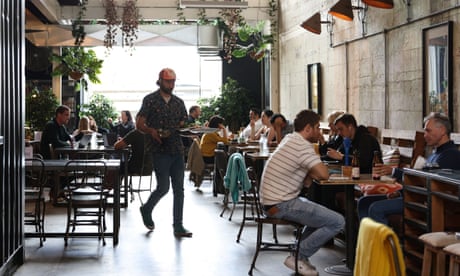- by foxnews
- 08 Apr 2025
Australians are spending hard, despite real wages falling. It’s a fragile situation | Greg Jericho
Australians are spending hard, despite real wages falling. It’s a fragile situation | Greg Jericho
- by theguardian
- 08 Sep 2022
- in news

I'm not sure any GDP figures have better demonstrated my maxim "you can't eat GDP" than the June quarter numbers released on Wednesday.
On the surface the 0.9% quarterly growth and 3.6% annual growth is very strong.
But you can thank people drawing down on their savings to spend, despite wages going backwards in real terms, rather than any boom in production. And behind it was all about company profits soaring.
Before we get to what is going on under the hood of the Australian economy, let us first note the big smile that the treasurer Jim Chalmers is no doubt struggling to contain.
While real GDP growth notionally gives a sense of the strength of the economy, nominal GDP is what most translates into tax revenue - and it is going crazy off the back of soaring inflation:
If the graph does not display click here
The inflation measure in the GDP figures rose 8.3% in the past year due to big surges in prices faced by households, construction and exports and imports:
If the graph does not display click here
So we have the economy seemingly growing strongly. Who gets the credit for it? Well, to be honest, you can thank yourself. Household consumption grew 2.5% in the June quarter alone. Take away that and the economy would have actually shrunk.
The spending by households and a surge in exports were the big drivers of the economy in the June quarter:
If the graph does not display click here
What were we spending our money on? Not food - we bought 1.2% less of that in the June quarter. But there was strong growth in clothing, utility bills (up 3.3%), health, and the operation of vehicles (yep - paying for petrol).
The biggest growth areas, however, were for transport and eating out. So great has been the increase in hospitality spending that it is now back above pre-pandemic levels. But transport spending still has a way to go:
If the graph does not display click here
So where did all this money come from? Not from wages. The big change is the reduction in amount we are saving.
During the lockdowns, the percent of income we were saving surged to record heights, mostly because of the stimulus measures like jobkeeper, the all-too brief boost to jobseeker, the record-low interest rates and our inability to go out and spend because of lockdowns and border closures.
Now our level of saving is almost back to pre-pandemic levels:
If the graph does not display click here
And we are very lucky that money was available to spend because the tale for workers is pretty dire.
Normally we look at GDP in terms of production and consumption, but we can also look at it in terms of income, and over the past year, the amount of income going to employees (known as the "compensation of employees") rose 6.9%.
That sounds great, but as noted above, the inflation measure of GDP rose 8.3%. That means in real terms employee incomes went backwards and actually detracted from GDP growth.
So why else did GDP increase?
One word: profits.
Total corporate profits rose 25% in the past year and 10% in the June quarter alone:
If the graph does not display click here
This is not much of a shock if you have been looking at how profits have been growing compared to wages recently.
If the graph does not display click here
And that means when we divvy up the national income there is now a record low share going to employees and a record high share going to profits:
If the graph does not display click here
It is a very curious situation. Household spending is providing most of the growth in the economy and yet household wages are going backwards in real terms while profits are exploding.
It demonstrates that the domestic economy is pretty fragile.
Yes, we're all spending a lot and exports are up, as are export prices, creating massive profits for mining companies.
And when you take out trade and households, what you're really left with is the public sector keeping things afloat:
If the graph does not display click here
In the past year the public sector added 1.6 percentage points to the annual GDP growth of 3.6%. That means almost half of economic growth came from governments.
Most of it was actual spending rather than investment. Public-sector infrastructure work added very little to the economy, while domestic private-sector consumption and investment went backwards.
That is not a healthy state of affairs.
Yes, we're out of recession; yes, the GDP recovery has been quite strong. But look at where it is all coming from - government spending, households reducing their level of savings, and companies making large profits, all the while real wages are declining and domestic private sector production is falling.
So the overall GDP is growing well, but we have an economy built on rather weak foundations. And once the impact of interest rate rises, continuing real wage falls and our declining savings all hit, the weakness underneath will likely be seen in the GDP growth as well.
- by foxnews
- descember 09, 2016
Ancient settlement reveals remains of 1,800-year-old dog, baffling experts: 'Preserved quite well'
Archaeologists have recently unearthed the remarkably well-preserved remains of a dog from ancient Rome, shedding light on the widespread practice of ritual sacrifice in antiquity.
read more


